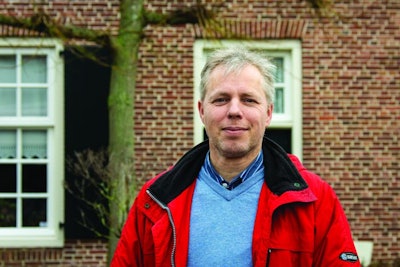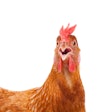
The Dutch poultry industry can celebrate a good number of successes, but it is not without its difficulties.
Bart-Jan Oplaat, a former poultry farmer and, since the end of 2021, chairman of industry association for Dutch Poultry Union (NVP), shares with Poultry International where the industry continues to make progress, but also details some of the obstacles that Dutch poultry producers are facing.
Still a frontrunner
In a small country such as the Netherlands, farmers are not always able to stand up to unfavorable government policies, particularly when those policies are populist, such as building houses and nature conservation, and farmers find themselves in the middle.
However, the Netherlands is still home to some of Europe's most successful broiler meat and egg producers. Additionally, it can count on the support of internationally recognized universities and research institutes, such as Wageningen University and Research Center and Schothorst Feed Research. The sector’s position, however, is increasingly under threat.
“Producing poultry in the Netherlands is efficient and animal welfare friendly and a prerequisite for us to maintain our leading position among poultry producers in Europe. However, the Dutch government thinks otherwise and has opted for a further reduction in farming. This is worrying," explains Oplaat.
According to the NVP chairman, the goal of many parties in the government to reduce all types of livestock farming in the Netherlands is detrimental. This is harmful not only for producers but for animal health, welfare and the environment, and it should not be this way.
He continues, "we are a frontrunner in producing poultry meat and eggs to the highest standards. We have a growing number of poultry farms with zero emission, we are very low on antibiotic use and have a number of animal welfare concepts."
More birds per farm
In 2015, a system of "production (poultry) rights" was introduced, which sets out the maximum number of birds a producer can keep. This started a period of consolidation in the Dutch poultry sector.
Oplaat continues, "farms that don’t have a successor are being bought by poultry farmers in the region. The farms become bigger, but overall, the sector is shrinking."
Between 2000 and 2020, the number of broiler farms in the Netherlands decreased from 1,094 to 637, a contraction of almost 42%. The number of layer farms decreased from 2,076 farms to 736, down by 64%. Unsurprisingly, the average number of birds per farm increased over this period.
“The critical mass of the poultry sector is disappearing; we are losing our leading position. It would be a shame if we were to lag behind in animal welfare and sustainability and the innovations that we have carefully worked on over the last decades," says Oplaat.
Major challenge
The main challenge for the Dutch poultry sector is to stay in business and maintain critical mass.
“Not only for food security and innovation power, but also for employment opportunities. Behind every Dutch farmer there are 10 people working. This equals 600,000 jobs," Oplaat explains.
“What if we stop production here and have to import poultry products from elsewhere? I doubt if these imported products can still comply with the high welfare and production standards that Dutch supermarkets ask from us."
Antibiotic use
Areas where the Dutch continue to lead and achieve success, however, are the fields of biosecurity and antibiotic use.
The yearly antibiotic reports from the certification body show that the use of antibiotics in broilers, for example, was 3% lower in 2020 than in 2019, and 75% lower than 2009, when the Dutch agreement for antibiotic reduction came into effect for livestock. For the poultry sector, this was also the time that central registration of antibiotic use started, first for broilers, a few years later for layers and then for turkeys.
In broiler breeders, a huge reduction of 30% was seen in 2020, compared to the previous year. A significant reduction in breeder layer birds was also recorded.
On layer farms, the use of antibiotics is very low, although a slight increase has been seen over the last five years.
“One of the possible reasons for this slight increase is keeping more layers in outdoor systems over the last couple of years. Outside, chickens are prone to infections," says Oplaat.
The turkey sector achieved a reduction of 57% in antibiotic use in 2020, compared to 2019 levels. In comparison with 2011, when centralized data recording started in the sector, this is a whopping 84% reduction.
“Preventive group treatments are something we haven't been doing for many years. Our low antibiotic use is the result of better awareness among farmers and poultry veterinarians, prevention measures, and improvements regarding chick feeding and management among others,” notes Oplaat.
Avian influenza
Despite high levels of biosecurity, the Dutch have been having to deal with several large outbreaks of highly pathogenic avian influenza (HPAI), which have had an enormous financial impact on the sector and an emotional impact for farmers.
In October 2021, HPAI hit again at a layer farm in Zeewolde, in the center of the country, and several more outbreaks followed. Since October 2021, a confinement order for all poultry has been in place nationally.
“The latest outbreaks are caused by a more virulent variant of the virus," notes Oplaat. “So even with the confinement order in place and no visitors entering the farms, new outbreaks still emerge. This is new. Nevertheless, the number of outbreaks is much lower in the Netherlands compared to the rest of Europe."
Oplaat is happy that there are finally steps being made for an AI vaccine.
“We have been asking for this since 2013. The first field trials are now being conducted in France with several types of vaccines."
The need for a vaccine is bigger than ever before as the number of waterfowl is increasing in the Netherlands.
“The risk of introduction of the virus and new strains increases each year. We have more geese than chickens. It’s crazy."

What lies behind the success of Dutch poultry and egg production?















